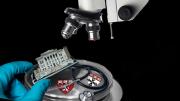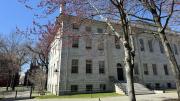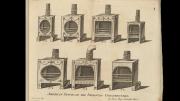Modern art was never more famously lampooned than when Tom Stoppard said, “Skill without imagination is craftsmanship and gives us many useful objects such as wickerwork picnic baskets. Imagination without skill gives us modern art.”
But recent work by Valpine professor of mathematics Lakshminarayanan Mahadevan suggests that at least in the case of Jackson Pollock (1912-1956), the artist did indeed employ skill. Pollock was experimenting with coiling fluids, one of Mahadevan’s areas of expertise, well before the first scientific papers on the subject appeared in the 1950s and 1960s. (To learn about Mahadevan’s other explorations of natural phenomena, see “The Physics of the Familiar,” a feature article from Harvard Magazine’s archives.)
Mahadevan and colleagues undertook a quantitative analysis of Pollock’s black and red painting Untitled 1948-49 and demonstrated mathematically that Pollock must have held his brush or trowel high off the canvas, moving it slowly as he let out a flow of paint that narrowed and sped up as it fell. The article, published in Physics Today, is “mainly an invitation to think about some aspects of art from a scientific perspective,” says Mahadevan, who collaborated with art historian Claude Cernuschi and physicist Andrzej Herczyński, both at nearby Boston College, on the project.
Mahadevan took an interest in Pollock when his colleagues suggested that the artist might have exploited the same aspects of fluid dynamics that he has studied in the past. Pollock's signature style involved laying a canvas on the floor and pouring paint onto it in continuous, curving streams. Rather than pouring straight from the can, he applied paint from a stick or a trowel, waving his hand back and forth above the canvas and adjusting the height and angle of the trowel to make the stream of paint wider or thinner. (Quantitative explanations for what are now termed inertial, gravitational, and viscous coiling regimes are relatively recent findings, elucidated only within the last few decades.) "My own interest," says Mahadevan, "is in the tension between the medium—the dynamics of the fluid, and the way it is applied (written, brushed, poured…)—and the message. While the latter will eventually transcend the former, the medium can be sometimes limiting and sometimes liberating."
Simultaneously restricted and inspired by the laws of nature, Pollock took on the role of experimentalist, ceding a certain amount of control to physics in order to create new aesthetic effects. The artist, of course, must have discovered the effects he could create through experimentation with various motions and types of paint, and perhaps some intuition and luck. But that, says Mahadevan, is the essence of science: "We are all students of nature, and so was Pollock. Often, artists and artisans are far ahead, as they push boundaries in ways that are quite similar to, and yet different from, how scientists and engineers do the same."
See also a video of other Mahadevan discoveries.









